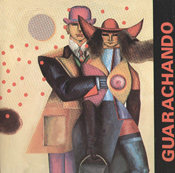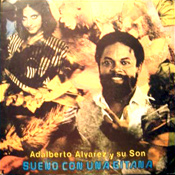Indice - Table of contents
Lo Nuevo[hide]
Grupos: Ritmo Oriental : 1988 - Vol. IX - 30 a...
Musicos: Rafael Paseiro Monzón
Musicos: Dennis Nicles Cobas
Musicos: Jiovanni Cofiño Sánchez
Musicos: Yasser Morejón Pino
Fotos: Tom Ehrlich : 2024 Monterey Jazz, P...
Resenas: Vacilón Santiaguero (Circle 9 ...
Staff: Bill Tilford
Fotos: Tom Ehrlich : 2024 Monterey Jazz, P...
Fotos: Tom Ehrlich : 2024 Monterey Jazz Fe...
Fotos: Tom Ehrlich : testing 123
Grupos: Pupy y los que S... : Discography - 1995- F...
Reportes: From The St... : Cubadisco 2...
Reportes: From The St... : Jazz Plaza ...
Fotos Del Día [hide]
The Roots of Timba, Pt. III - 1987 - Ritmo Oriental
 Ritmo Oriental -- Guarachando was la Ritmo's last album with Tony Calá and it was a powerful finale.
Ritmo Oriental -- Guarachando was la Ritmo's last album with Tony Calá and it was a powerful finale.
The first track, Azúcar a granel, is a work of art. Not a note is wasted. Every phrase of Humberto Perera's strikingly original arrangement seems to lead inevitably to the next.
The opening passage [source for all] foreshadows timba in several important ways. As would become common in the 90s, the arrangement begins with a preview of the montuno section, and a particularly clever one that introduces the theme of the montuno in a different key in order to accommodate one of la Ritmo's most complex harmonic structures. The instruments enter one by one with the type of rhythmic ambiguity that would become the calling card of Charanga Habanera years later. The bass tumbao is silent on the first beat of the phrase, but since it enters completely alone it sounds like pickups into the downbeat of the 2-side, setting the stage for a startling denouement when the piano entrance reveals that we're really in 3-2.
0xx0 xxx0 xx0x 0xxx 3-2 rumba clave
xxx0 0x0x 0x0x 0x0x bass tumbao
xxxx xxxx xxxx xxx0 piano enters on anticipation
x000 0000 x000 0000
x000 0000 0000 0000 piano tumbao
Because the bass is always silent on the first beat, and rhythmically divorced from the piano, the left hand of the piano becomes a de facto second bassline, creating the unusual and effective progression, in the key of F:
An unusual sequence of voicings brings us to a beautiful cuerpo worthy of Jobim or Piloto, and then, just as we seem to be settling into coro 1, still in F, we get this unusual sequence of voicings! It sounds like something out of a Yellowjackets or Weather Report song, but this is no heavy-handed attempt at "fusion" - listen to how seamlessly and naturally it fits into the context of the arrangement, bringing us back to the striking opening tumbao, now in the key of C.
In our search for the roots of timba, Tony Calá's singing and songwriting in this period is an absolute revelation. These songs clearly had a huge influence on the material El Tosco wrote for him to sing in the early 90s, andit's equally clear that many aspects of Tony's style with NG had already been perfected before he joined the group. Listen to this sublimely perfect guía for example.
The second montuno of Azúcar a granel is quite different and in live performance was often extended for several minutes or longer. This was another important innovation in which Ritmo Oriental had a central role -- the idea of multiple montuno sections with different tumbaos and chord progressions. The early genres of son and danzón involved adding clave rhythms to European songforms and instrumental dance music. Later, the arrangements were expanded to add the African idea of call and response vocals. When these sections became longer and were combined with repeating horn figures, the genres became son-montuno and danzón-mambo, respectively. Now, in the 80s, we start to encounter forms that could be described as son-montuno 1-montuno 2, and by the time we reach the late 90s we'll sometimes find three different montuno sections -- each with unique piano and bass tumbaos, and each with multiple coros and mambos.
The second track, Bailadores, is a brilliant Perera arrangement of a song by Buena Vista Social Club figure Remberto Bécquer, who was already in his 70s at that point. Tony Calá is in his absolute prime in a coro section that creates so much rhythmic tension that it finally has to resolve into a folkloric groove. Next comes a conga solo from Juan Claro Bravo against a motivo figure, followed by a Polo Tamayo flute solo played over what could be thought of as the "title coro", "sé que tú quieres guarachar, yo sé que tú quieres guarachar". The same coro returns on the last track, Baila, si vas a bailar.
Before leaving Bailadores we should mention the "mystery version" that made it into Victor Barrientos' hands on an old cassette. The audio is distorted, but the performance is longer and more adrenaline charged, varying most from the released version in the final sections [write EGREM]. And before arriving at the grand finale, we should also mention Por eso voy a dejarlo -- a Cuban anti-smoking song! You have to visit there to fully appreciate the irony. It was apparently mandated by the government when Fidel himself was kicking the habit.
Baila si vas a bailar starts with a very clever paraphrase of Beny Moré's Elige tú [source], which timba fans will recognize from Michel Maza's version [source]. The song says, basically, "you choose - I can sing anything", but Tony sings it from a dancer's perspective, changing the words accordingly.
The track is packed with highlights, including a rare drum solo from the great Daniel Díaz and the afore-mentioned reference to the "guarachar" coro, but the pièce de resistance is the last montuno section -- with Tony soaring over one of the band's most euphoric grooves, leading up to perhaps the most beautiful and audicious example of "clave license" in Cuban music. In midst of a throbbing 2-3 tumbao, Tony sings "para bailar el son, son, son, son, son". The band stops on a dime and makes a bloque out of "son son son son son". The rhythm? 3-2 rumba clave! After laying out for the space of one more clave, they re-enter in 2-3. During the intervening silence, Tony sings "la clave se lleva en el corazón" ("the clave is carried in the heart"). There could no more poetic way to explain, demonstrate, and vindicate "clave license", and to make it even more perfect, it's almost certain that the band was completely oblivious to any of this. They just played it like they heard it and it was so great that they repeated it at the end of the track, which was also the end of the album, and, as the reverbation of the closing bloque fades away like the coda of a symphony, we come to the end of the second great era of la Ritmo Oriental. When Tony Calá recorded again, it would be with NG La Banda.
 Adalberto Alvarez: Sueño con una gitana -- In 1939, Spanish composer Joaquín Rodrigo wrote perhaps the most recognizable piece of symphonic music of the 20th Century: Concierto de Aranjuez. Old-school jazz fans know it as Miles Davis' Sketches of Spain; younger jazz fans know it as Chick Corea's Spain; timba fans know it as the barn-burning instrumental with the dazzling Feliciano Arango bass solo that NG La Banda used to open its live shows in the late 90s. Now we learn that Adalberto appropriated it about 10 years earlier for the introduction [source] of Sueño con una gitana. AA continued his approach of beginning each album with a striking and unusual intro that segues into the title track, in this case a strong original with flamenco harmonies and several hints at timba gears in the rhythm section. This is singer Félix Baloy's third album with Adalberto after his marvelous 1982 recordings with Revé.
Adalberto Alvarez: Sueño con una gitana -- In 1939, Spanish composer Joaquín Rodrigo wrote perhaps the most recognizable piece of symphonic music of the 20th Century: Concierto de Aranjuez. Old-school jazz fans know it as Miles Davis' Sketches of Spain; younger jazz fans know it as Chick Corea's Spain; timba fans know it as the barn-burning instrumental with the dazzling Feliciano Arango bass solo that NG La Banda used to open its live shows in the late 90s. Now we learn that Adalberto appropriated it about 10 years earlier for the introduction [source] of Sueño con una gitana. AA continued his approach of beginning each album with a striking and unusual intro that segues into the title track, in this case a strong original with flamenco harmonies and several hints at timba gears in the rhythm section. This is singer Félix Baloy's third album with Adalberto after his marvelous 1982 recordings with Revé.
The most famous and harmonically interesting song from this album is Cántalo pero baílalo, [source] written by trovador Silvio Rodríguez and utilizing the suku-suku [source] rhythm from Volume II of the Tomás Cruz series.





















